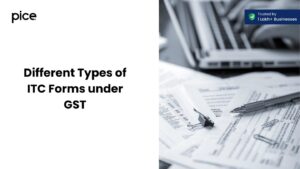Step-by-Step Guide to Filing Debit Notes in GSTR 1
- 6 Sep 24
- 11 mins

Step-by-Step Guide to Filing Debit Notes in GSTR 1
Key Takeaways
- Debit Notes Adjust Tax: Debit Notes correct invoice errors and adjust tax liability under GST.
- Used by Both Parties: Sellers issue for price increases; buyers for returns or discrepancies.
- Essential for Compliance: Proper reporting of Debit Notes in GSTR-1 is crucial to GST compliance.
- Affects ITC: Debit Notes can require adjustments to Input Tax Credit (ITC).
- Ensures Transparency: Clear Debit Notes reduce disputes and improve business transparency.
A Debit Note is a commercial document issued by a buyer or seller to the other party to indicate an adjustment in the amount due between them. It generally reflects an increase in the amount payable by the recipient or a correction of previously issued invoices. Here’s how it works when issued by both parties:
Issued by a Seller:
When a seller issues a Debit Note, it usually indicates that the original invoice amount was understated or that additional charges need to be levied on the buyer due to reasons such as errors in pricing, increased quantity of goods delivered, or additional services rendered. The Debit Note serves to notify the buyer of the increased liability and is often accompanied by a revised invoice reflecting the correct amount.
For example:
- Additional Supplies: The seller delivered more products than originally invoiced, so a Debit Note is issued for the additional amount.
- Price Adjustment: If the seller undercharged on the initial invoice, they issue a Debit Note to correct the price discrepancy.
- Error in Original Invoice: If an error was made in the original invoice, such as an incorrect tax rate or quantity, the seller uses a Debit Note to correct it.
Issued by a Buyer:
When a buyer issues a Debit Note, it typically indicates that they are returning goods to the seller, or they require a refund for goods that were faulty, damaged, or not as per the agreed terms. This document acts as a formal request for a credit adjustment in the buyer’s account, leading to either a reduction in the amount owed to the seller or a refund.
For example:
- Purchase Returns: If the buyer returns goods due to defects or other issues, a Debit Note is issued to request a reduction in the payable amount or a refund.
- Discrepancies in Supply: If the goods received are less in quantity or different from what was ordered, the buyer issues a Debit Note to reflect the reduced liability.
Debit Note Format

A Debit Note should be comprehensive and clear, ensuring all necessary details are included for accurate reporting and compliance. Below are the key elements that should be present in a Debit Note issued by a supplier:
- Supplier’s Details:
- Name, address, and GSTIN (Goods and Services Tax Identification Number).
- The registered person (supplier) must include their registered business name as it appears in the GST records.
- Buyer’s Details:
- Name, address, and GSTIN (if applicable).
- The recipient or registered person’s details ensure the document's validity and proper accounting.
- Debit Note Number and Date:
- A unique serial number for the Debit Note, which should be sequential and not repeated within the financial year.
- The issuance date is crucial for compliance, as it must align with the reporting in the GST returns.
- Original Invoice Details:
- Reference to the original tax invoice number and date.
- This linkage is vital for both the supplier and buyer to track and adjust the entries accordingly.
- Reason for Issuance:
- A clear explanation of why the Debit Note is being issued, such as additional charges, rate of tax adjustments, or errors in the original invoice.
- This section ensures transparency in the transaction and aids in accurate reporting.
- Description of Goods or Services:
- Detailed description of the goods or services for which the Debit Note is being issued.
- Include the quantity, rate of tax, and applicable tax rate to ensure clarity and compliance with the GST requirements.
- Tax Details:
- The applicable tax rate, rate of tax, and the amount of tax charged.
- Proper calculation and mention of the tax rates help in the accurate reporting of outward supplies and the resultant tax liability.
- Total Amount:
- The total amount that the buyer is liable to pay after considering the additional charges or corrections.
- This amount should reflect the increase in the tax liability due to the issuance of the Debit Note.
- Signature:
- Signature of the authorized person issuing the Debit Note, along with their designation.
- The signature signifies the document’s authenticity and correctness.
Reporting and Compliance
The issuance of a Debit Note is not just a financial adjustment but also a crucial compliance requirement under GST. The supplier must ensure that the details of the Debit Note are accurately reported in their GST returns, particularly in GSTR-1.
- Reporting in GSTR-1: The Debit Note details must be included in Table 9B of Form GSTR-1, where credit and debit notes are reported. This ensures that the additional tax liability is appropriately reflected and adjusted against the supplier’s outward supplies.
- Impact on Input Tax Credit (ITC): The buyer must adjust their Input Tax Credit (ITC) based on the Debit Note received. If the buyer had already claimed ITC on the original invoice, they must reverse the excess ITC claimed.
- Time Limits: As per GST regulations, the Debit Note should be issued within the prescribed time limits to ensure its validity and proper reporting in the annual return.
Compliance with GST Returns
Ensuring compliance with GST returns is paramount when handling Debit Notes. The supplier must be diligent in reporting the Debit Note within the correct reporting period, typically in the return for the month in which the Debit Note was issued. Failure to do so can result in penalties or interest charges for incorrect reporting or non-compliance.
Transparency and Business Integrity
A well-drafted Debit Note enhances transparency in business transactions. It ensures both the supplier and the buyer have a clear understanding of their respective financial obligations, reducing the chances of disputes and ensuring smoother business operations.
Step-by-Step Guide on Creating a Debit Note
Creating a Debit Note is a critical task for businesses, especially under the Goods and Services Tax (GST) law. A Debit Note serves as an official document indicating an increase in the amount owed by the recipient, usually due to errors or adjustments in the original invoice. Here’s a step-by-step guide to help you create a Debit Note:
Step 1: Gather Necessary Information
- Supplier Details: Include your business name, address, and GSTIN (Goods and Services Tax Identification Number).
- Buyer Details: Gather the buyer’s name, address, and GSTIN, if applicable.
- Original Invoice Information: Have the original tax invoice number and date on hand to reference in the Debit Note.
Step 2: Format the Debit Note
- Debit Note Number: Assign a unique, sequential number to the Debit Note. This number should not repeat during the financial year.
- Date of Issuance: Clearly state the date on which the Debit Note is issued.
- Reason for Issuance: Provide a concise explanation, such as “price adjustment,” “additional supply,” or “error correction.”
Step 3: Detail the Transaction
- Description of Goods/Services: List the goods or services involved, including quantities and applicable tax rates.
- Adjustment Amount: Indicate the additional amount the buyer is liable for, including the revised tax liability.
- Total Amount Payable: Clearly state the new total amount payable by the buyer after adjustments.
Step 4: Review Tax Calculations
- Rate of Tax: Ensure the correct tax rate is applied to the additional amount.
- Total Tax Amount: Calculate the total tax payable on the increased amount and ensure it is accurately reflected.
Step 5: Signature
- Authorized Signature: The Debit Note should be signed by an authorized person, confirming the accuracy and validity of the document.
Step 6: Issuance and Distribution
- Distribute the Debit Note: Provide a copy to the buyer for their records and ensure it is entered into your financial and GST records.
Importance of Debit Note under GST Law
A Debit Note holds significant importance under GST law for several reasons:
- Adjustment of Tax Liability: It helps in adjusting the tax liability for both the supplier and the recipient by correcting any errors or omissions in the original tax invoice.
- Compliance and Transparency: Issuing a Debit Note ensures compliance with GST regulations, fostering transparency in business transactions and reducing the risk of disputes.
- Impact on Input Tax Credit (ITC): Debit Notes impact the recipient's ability to claim ITC, especially if they had already claimed ITC based on the original invoice. The recipient must adjust their ITC accordingly.
Process of Updating a Debit Note in GSTR-1

Updating a Debit Note in GSTR-1 is an essential part of GST compliance. Here’s how to do it:
Step 1: Log into the GST Portal: Access the GST portal using your credentials.
Step 2: Navigate to GSTR-1 Filing:
- Go to the "Services" section, then "Returns," and select "GSTR-1" for the relevant period.
Step 3: Enter Debit Note Details:
- Go to Table 9B of the GSTR-1 form, where Credit and Debit Notes are recorded.
- Enter the details of the Debit Note, including the original invoice reference, Debit Note number, date, and the adjusted amount.
Step 4: Verify and Submit:
- Double-check all entries to ensure accuracy.
- Submit the form and complete the filing process.
Step 5: Acknowledgment:
- Once submitted, the system will generate an acknowledgment. Save this for your records.
Reasons for Issuing a Debit Note
There are several reasons why a supplier might issue a Debit Note:
- Price Adjustment: When the price of goods or services is incorrectly stated in the original invoice, a Debit Note is issued to reflect the correct amount.
- Additional Supply: If additional goods or services were supplied beyond what was originally invoiced, a Debit Note is issued for the extra amount.
- Incorrect Tax Rate: If the tax rate applied in the original invoice was incorrect, a Debit Note is used to adjust the tax amount.
- Error in Quantity: If there was an error in the quantity of goods or services invoiced, such as an understatement, a Debit Note corrects this by reflecting the actual quantity supplied.
Conclusion
In the context of GST compliance, understanding the issuance and reporting of Debit Notes and Credit Notes is crucial for accurate tax liability management. A Debit Note, issued to correct the original invoice amount, impacts taxable supply and Input Tax Credit (ITC), requiring proper reporting in Form GSTR-1.
Similarly, Credit Notes, often issued for sales returns or invoice adjustments, must be accurately recorded to ensure transparency in business transactions and compliance with GST regulations.
Ensuring the correct format and timely submission of these documents helps avoid accounting errors and penalties, maintaining transparency and compliance in business dealings.
💡If you want to pay your GST with Credit Card, then download Pice Business Payment App. Pice is the one stop app for paying all your business expenses.



















